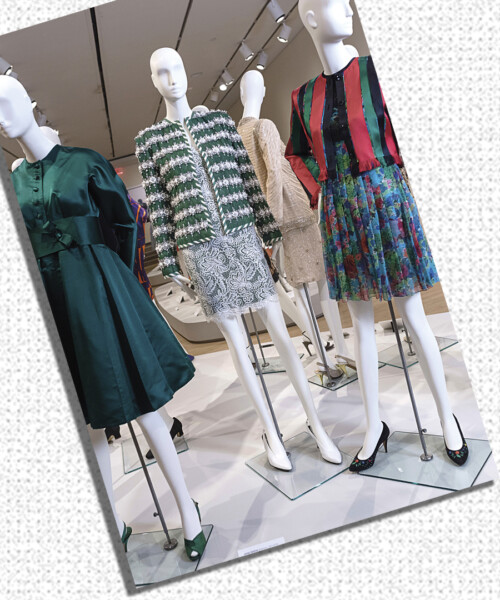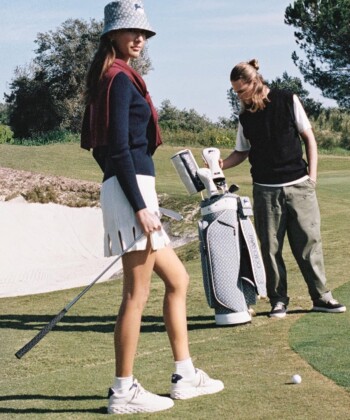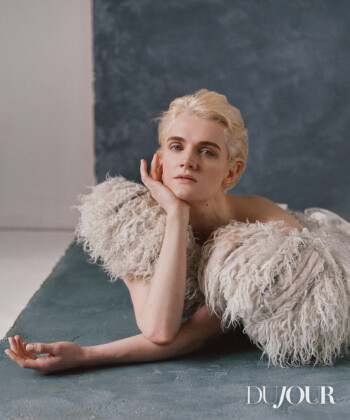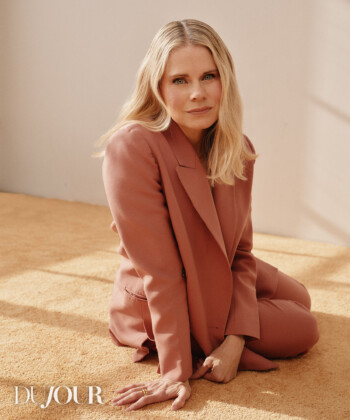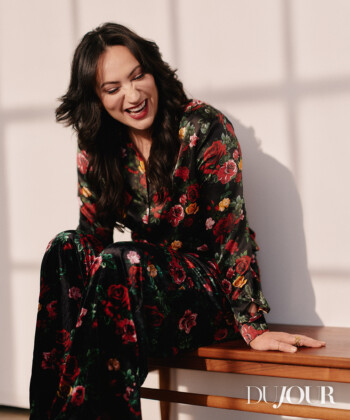For over half a century James Galanos designed clothes with the skill of a Paris couturier. From his exacting fabric selection to impeccable construction and finishing, his standards emphasized elegance and simplicity. “A black dress,” he said, “reveals everything—line, cut, drape, seaming. It must be perfection.”
Born in Philadelphia in 1924, Galanos was the only son of Greek-born parents and a self-described “loner” growing up in New Jersey, where his father ran a restaurant. He began sketching at an early age and his three sisters, whom he would design dresses and ensembles for, served as his first muses. In a 1980 People magazine article, he recalled, “As a young boy I had no fashion influence around me but all the while I was dreaming of Paris and New York.” After high school, Galanos enrolled at New York’s Traphagen School of Fashion.

Archival editorial materials showcasing the work of James Galanos on display in the Ellman Fashion Design Gallery of Phoenix Art Museum.
His real entrée into the industry was in 1944 as an assistant at the milliner and evening wear designer Hattie Carnegie’s New York emporium, which led to a series of jobs including part-time sketch artist under Jean Louis at Columbia Pictures, and later assistant to the couturier Robert Piguet in Paris. In 1952, he opened Galanos Originals in Los Angeles, where his first ready-to-wear collection was ordered by Saks Fifth Avenue. Fashion mavens like Diana Vreeland and Eleanor Lambert took notice, solidifying Galanos’s reputation as a master craftsman.

The designer with Nancy Reagan in the mid-’80s.
Photo courtesy of David Nash
When Galanos passed away in October of last year at age 92, his friends worried that he would be remembered simply as Nancy Reagan’s favored designer rather than as a visionary and artist in his own right. Reagan, whose deep friendship with Galanos continued until her death eight months before his own, wore his designs to all four of her husband Rondald Reagan’s inaugural balls: the first two when he was elected Governor of California in 1967 and 1971, and later to both presidential inaugural balls in 1981 and 1985.
The designer may be forever linked to the late former First Lady, but Phoenix Art Museum’s exhibition “A Tribute to James Galanos,” on view until January 7, has quelled fears that Reagan would define Galanos’s legacy. The first dedicated show since his passing, the retrospective details Galanos’s work from the 1950s through the 1990s with over forty ensembles, of which just one belonged to Reagan. “Mr. Galanos had a solidly defined style, and vast body of work, for three decades before the Reagan era,” explained Dennita Sewell, the Jacquie Dorrance Curator of Fashion at Phoenix Art Museum.
The venue of the show is one personal to Jimmy (as he was known to friends), whose travels brought him to Arizona. Impressed by the archive at the Phoenix Art Museum, which houses the Arizona Costume Institute’s collection of garments, accessories, and shoes from the 18th century to the present day, he began donating his pieces to the museum in 1990. “His clothes stand out, even in a world-class collection, for the quality of the fabrics, construction and timeless appeal,” said Sewell. “The way they were finished inside and out was on the level of French couture, but with a purely contemporary American sensibility.”
By the time I met Jimmy in 2005, he had been retired from designing for seven years, having closed his atelier in 1998 at 74 years old and still at the top of his game. We were introduced by ’90s supermodel-turned-fashion editor Tatiana Sorokko, whose husband, art dealer and publisher Serge Sorokko was helping direct Jimmy’s second act as an abstract photographer. On the evening of his 82nd birthday in September 2006, Jimmy had his art world debut with an exhibition of 60 mostly large-scale photographs at Serge’s eponymous gallery in San Francisco.
In fashion, Jimmy was renowned for his unorthodox mix of colors, fabrics and textures, and the same unorthodoxy could be seen in his photography. To achieve his highly abstracted works, he would transform the kitchen of his 1940s Hollywood home on Sunset Plaza Drive with lamps clamped to cupboard doors, illuminating an array of fabrics, paper cut-outs and other objects that he had arranged into various configurations. He’d play with the lamps to create dimension and adjust the levels of light and shadow. The trick to creating one of his favorite effects was to photograph his subject matter through a Lalique bowl, which created a sort of liquid distortion to the image. When Jimmy explained this homespun technique to me, I thought to myself: “He’s an absolute genius.”

A view of the exhibition in Phoenix Art Museum’s Ellman Fashion Design Gallery.
Photo courtesy of Phoenix Art Museum
During our decade-long friendship, I had the pleasure of spending time with him in San Francisco, Los Angeles and Phoenix, and across the globe on a memorable trip through Moscow and St. Petersburg. Jimmy’s highly cultured sense of style was rivaled only by his wry sense of humor. Generally self-effacing and sometimes self-deprecating, he once told me that, as a child, he felt he “resembled an asparagus with eyes.” He taught me how to see the importance in the smallest details—and how to properly twist, not fold, a pocket square. When I would visit him at home, he’d have gone through his closet in advance and pulled things to give me that he could no longer wear—for instance a pair of crisp, pale blue custom-made dress shirts with white French cuffs and collar. On the chest of each I noticed “JG” modestly embroidered in a contrasting blue. “You can wear these under a nice blazer,” he explained. This was followed by one of his favorite phrases, “Or what have you.” In addition to these gifts, I also began to collect and preserve his work.
A selection of garments from my personal collection are in the PAM show, including two gowns that appeared on the July 1963 cover of Harper’s Bazaar. The complementary looks, photographed by Melvin Sokolsky, were described by the magazine with the utmost reverence: “Galanos sets off a whole new way to shine in one’s private world with fantastically colored, neoclassic columns of wool jersey. Exuberant Roman candle stripes shoot skyward on the skirts, mists of silk chiffon veil the tops.”
Another of my dresses, also from his 1963 Spring/Summer collection, was featured that March in editorials shot by Milton Greene for LIFE, and full-page by Hiro for Bazaar, in which it was described as “a column of crepe—cocoa brown asymmetrically printed with lightning strikes of pale beige and jet black—completely covering, supple, clinging … the most contemporary look possible.” What no one ever realized, Jimmy explained to me, was that the dress was an homage to Italian artist and founder of Spatialism, Lucio Fontana, whose work he greatly admired. Again, I thought to myself, “He’s a genius.” This seminal combination of fashion and art predated Yves Saint Laurent’s celebrated Mondrian collection by two years, and Jeff Koons’s collaboration with Louis Vuitton, emblazoning masters’ works on the brand’s leather goods, by over 50 years. In fact, the dress has been immortalized multiple times; it was featured in an image titled “Iris on Vogue” by Sokolsky, which was recently displayed at the Fahey Klein Gallery in Los Angeles, and an identical copy—and the only other known to exist—is in the permanent collection of The Met.
Other pieces on display at PAM were lent by formidable collectors including Sorokko, artist Suzy Kellems Dominik and Houston socialite Susanne Byram (née Dawley). Byram, who cofounded the Costume Institute of the Houston Museum of Fine Art, was a friend and client in the ’80s and ’90s, and presented Jimmy with the museum’s inaugural Silver Slipper award for Design Excellence.
“My clients are worldly ladies,” Galanos explained in a 1985 interview for Connoisseur magazine. “They go to the grand restaurants. You see them in London, Paris, Rome. Clothes represent who they are.”
Until his retirement, Jimmy faithfully designed clothing, sumptuous furs and accessories for his discerning clientele—and served as an inspiration to his peers. “He was a legend—a success,” says Galanos’ confidant and fashion designer Ralph Rucci. “He never looked back on the past.” Rucci first met Jimmy in 1989 and formed an immediate bond with the elder designer. “He would come to every show I had in New York and Paris,” explains Rucci. “He would come earlier to sit through the fittings. There was one very special collection in Paris – spring 2005 couture—and I had a faille dress in alabaster with a belt that I was struggling with,” he says. “Jimmy was sitting silently sketching in the corner watching my struggle. Calmly he stood up and asked, ‘Can I help?’ He took a pair of scissors and with two cuts he had the problem solved.”
“When you look at his overall career, nobody else in American fashion achieved what he did,” says Tatiana Sorokko. “He produced everything in the United States from his factory on Sepulveda Boulevard in Los Angeles.” Rucci adds, “It was simply staggering—his beading and embroidery looked as though it came from Lesage in Paris.”
“James Galanos was the only person who would travel twice a year across the country for presentations with fifteen to twenty 11-foot trunks on wheels,” explains Rucci. “The garments were hung perfectly on hangers, each wrapped with generous amounts of tissue so they wouldn’t press against each other—and he did it all himself. It was ready-to-wear shipped as haute couture.”
Jimmy will forever be distinguished by his contributions to the establishment of a contemporary American style for five decades. His ability to evolve and remain relevant all those years is extraordinary, but his reputation for quality is unsurpassed.


























